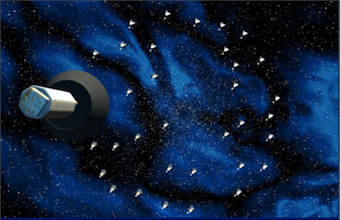Originally proposed by Antoine Labeyrie to bring innovative solutions to the observational challenges posed by the search and tracking of exo-planets (Labeyrie 1996), the concept of hypertelescopes has been studied and tested on the ground at Barrosa in the Spanish Pyrenees and at Ubaye. Some exploratory studies have also been undertaken to develop spatial versions of the instrument.
The feasibility of a space hypertelescope consisting of a flottilla of mirrors arranged on a virtual surface of 100 km in diameter has already been explored: the numerical simulation predicts that it is possible to obtain direct images of an exo-Earth located ten light-years away, showing details of continents and green zones (Labeyrie 1999).
After a study of the concept of an Exo-Earth Discoverer proposed to NASA was undertaken, a larger version of the instrument – named “Luciola” – was submitted to ESA (Labeyrie et al. 2009).

Depiction of the hypertelescope mirrors’ flottilla Exo-Earth
Discoverer proposed to NASA. In the foreground,
the focal satellite that collects light from the flotilla of mirrors
receiving light from the star.
In 2010 a flight training test was conducted with the “Prisma” French-Swedish experiment. This tested the relative control of two small satellites equipped with micro-rockets (Tango et Mango) and proved suitable to control the flottilla of mirrors with interferometric accuracy.
An alternative mode of control has also been proposed (Labeyrie et al. 2009). It makes use of a concept proposed in 1979 (Labeyrie 1979) that has been studied by NASA. The flottilla comprising several small mirrors that must be controlled is trapped in a paraboloid surface using stationary waves generated by a pair of laser beams. Theoretically studied using numerical simulations, this type of trapping is also the subject of laboratory experimentation. At the Non Linear Institute of Nice (INLN, Université Nice Sophia Antipolis) Umberto Bortolozzo and Stefanie Residori have begun experiments with an UHV (Ultra High Vacuum) simulator (Labeyrie et al. 2010). Piloting a flottilla of small mirrors by laser trapping may be more accurate, more reliable and more economical than using the micro satellites such as Tango and Mango, whose micro-rockets have a limited operating time.
References :
- A. Labeyrie. Standing wave and pellicle - A Possible Approach to Very Large Space Telescopes. Astronomy and Astrophysics, vol. 77, n° 1-2, L1-L2, 1979.
- A. Labeyrie. Resolved imaging of extra-solar planets with future 10-100 km optical interferometric arrays. Astronomy and Astrophysics Supplement Series, vol. 118, 517-524, 1996.
- A. Labeyrie. Snapshots of Alien Worlds – The future of interferometry. Science, vol. 285, n° 5435,1864-1865, 1999.
- A. Labeyrie et al. Luciola hypertelescope space observatory:versatile upgradable high-resolution observing from stars to deep-field cosmology. Experimental Astronomy, 2009.
- A. Labeyrie, H. Le Coroller, S. Residori, U. Bortolozzo, J.-P. Huignard, and P. Riaud. Resolved imaging of extra-solar photosynthesis patches with a "Laser driven hypertelescope flotilla". Pathways towards habitable planets, ASP Conference series, vol. 430, 2010.


